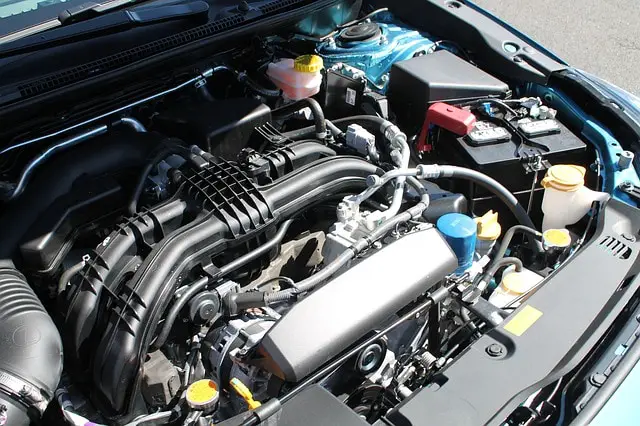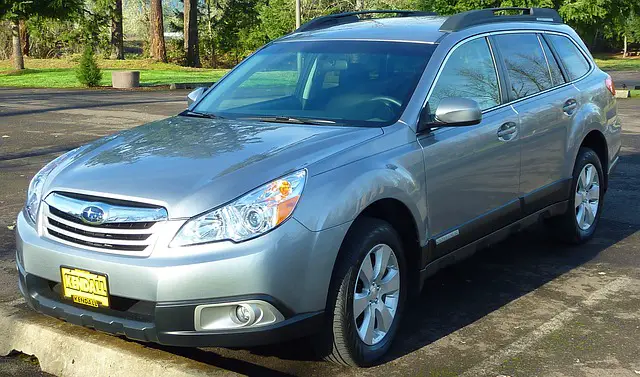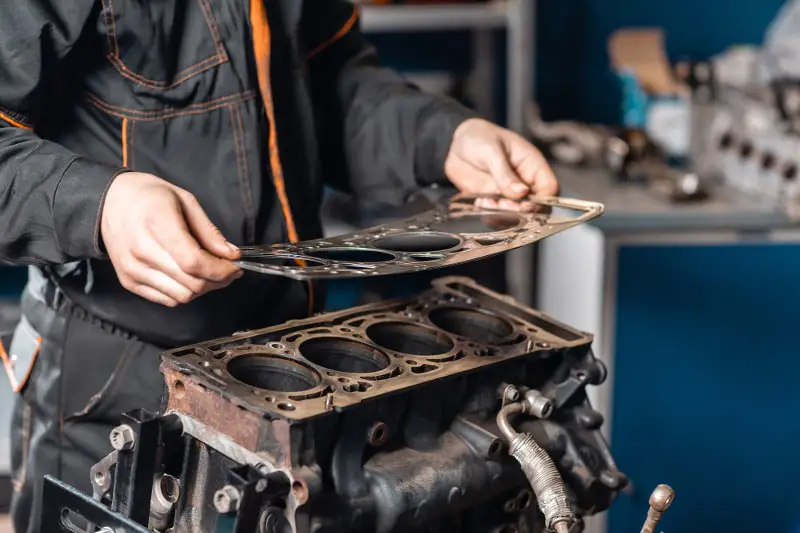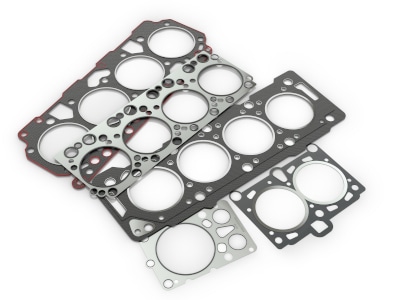Hey I’m Mike. Today we’re tackling the dreaded Subaru head gasket problem.
My buddy John called me the other day and said his Subaru Forester had white exhaust coming from the tailpipe (a classic symptom of a failing head gasket). We ran the car over to the garage, let it cool down, pulled the dipstick and sure enough, the oil was a milky white color.
He had head gasket issues.
Do you suspect a blown head gasket on your beloved Subaru? If you’re fuming upset right now, you’re not alone. Lots of Subi’s have gasket failures and you’re not alone.

Do you own a Subaru? Read this to avoid costly repairs!
Subarus are amazing, and the brand enjoys a loyal customer base. That doesn’t mean they’re perfect. The 2.5 liter 4-Cylinder engines are notorious for leaking head gaskets. Problems plagued every model for nearly a decade starting in the late 1990s.
Have you noticed your temp gauge running a little hotter than usual? Did you catch your mechanic hiding a smile when you pulled up for service? Does the repair bill make you suspect you’re paying the shop’s entire rent this month?
You may be suffering from the dreaded Subaru head gasket problems. We’ve seen this sort of thing before. Let’s answer some of your questions.
What Exactly Is a Head Gasket?
Your engine’s head gasket is a thin strip of metal with an assortment of holes punched through it. These gaskets sort of resemble slices of swiss cheese, and during the engine assembly process, they get sandwiched between the block and the cylinder heads.
A head gasket’s job is to take up the tolerances between the two heavier metal components. A good seal contains combustion chamber pressures. The gaskets are also supposed to keep the oil in the oil passages and the coolant flowing through the coolant jackets.
A precise torque procedure pins the gasket flush with both metal surfaces to firmly seal everything in place. Head gaskets are supposed to last the life of an engine and should only require replacement with major repair work.
Most people don’t realize it, but gaskets are moving parts. Though bolted firmly in place, slight shifts in position occur as the engine heats and cools. Every operating cycle causes the head and block to absorb and dissipate heat at different rates putting pressure on the seals.
Signs of a head gasket failure are quickly noticed. The engine loses the ability to contain the combustion pressures. Explosive forces make their way into places they shouldn’t be. Oil and coolant find new homes as well.

Why Do Head Gaskets Fail On Subarus So Often?
Any internal combustion engine might experience a head gasket failure, but Subaru’s engines earned their reputation for this particularly troublesome issue. The design is one contributing factor, but the real problem comes down to unreliable material in the gaskets.
Head gasket problems affect Subaru’s EJ25 engines. This 2.5-liter powerplant has several configurations and received many updates during its production run. They initially had faulty composite style gaskets. The manufacturer attempted to correct the issue in 1999 with an updated multilayered metal shim gasket.
Affected models include:
- Forester from 1999 through 2010
- Impreza from 1999 through 2011
- Outback from 2000 through 2009
- Legacy from 2000 through 2009
- Baja from 2003 through 2005
Subaru likes boxer-style engines. These motors lay flat instead of standing up. The pistons move side to side. The name “Boxer Engine” comes from the way the throws on the crankshaft resemble a pair of boxers squaring off.
Boxer engines have fantastic balance and weight properties. They sit lower in the vehicle improving handling, but fluids tend to pool next to the head gaskets instead of draining when the motor is off. Even with the updated parts, acids in the fluids eat away at the seals.
Shouldn’t Subaru Cover the Cost of Repairs?
It sure seems like the manufacturer should take responsibility for the defective parts. If you own a Forester and your head gasket goes out, expect a bill of at least $1000 for the parts and labor.
It’s not always cheap to own a Subaru…
While Subaru seemed to acknowledge the defect by redesigning the part, the manufacturer has done little to help frustrated owners. The failure usually occurs between 80,000 and 100,000 miles which is well out of the new vehicle warranty range.
Worse, there is no recall. Most consumers are not aware that manufacturer recalls are voluntary unless the defect causes a safety or emissions risk. A leaky head gasket doesn’t really put you in any danger, and a melted engine produces zero emissions. As far as the federal government is concerned, that’s a win.
Consumers are on their own. Fortunately, the National Highway Safety Administration posts free information about complaints and recalls for specific models. If you are concerned, check to see what other owners are reporting to the government.

Has Subaru done anything about their infamous head gasket failure?
Subaru has certainly improved the head gasket failure rate, but they certainly haven’t fully eliminated the issue. The thing we’ve noticed is the the older the car, the more chance of HG issues – This could be because of the high mileage as all vehicles start breaking down at a certain point! –
You’d like that Subaru would have fixed this years ago, but here’s what we’ve found:
Time-line of vehicles affected1996-1999: Most Subie’s in this year are very susceptible (Outback, Forester, WRX)
2000-2002: This year range improved significantly but there’s still a few out there than will get an external coolant leak. Keep a close eye on your coolant!
2003-2009: Similar to the 00-02 models, but the symptoms to watch for is an oil leak. It’ll usually rear it’s ugly head around 20-40k miles, but if you make it past that you’re probably safe.
2009-2012: Newer models should have far less issues than their younger generations. We suspect the reason for this is Subaru finally starting to use an MLS (Multi-Layered Steel) Cylinder-Head Gasket.
2012-current: Rumors are that the Subaru Outback engine was re-designed from the ground up about 2012. This new motor should completely fix the leaking issues. Time will tell!
To all our friends out there with older models, stay safe!
What are Signs of a Blown Subaru Head Gasket?
If you’ve got one of the older models with composite gasket, your engine faces a greater threat of overheating. When those gasket materials starts to erode, you might notice some of the following symptoms:
- White exhaust from the tail pipe
- Milky white oil in the reservoir
- Overheating engine
- Exhaust bubbles and pungent vapors in your coolant reservoir
- When the condition advances, your vehicle overheats in extreme driving conditions
The seals rupture at the cooling jackets permitting exhaust vapors and combustion pressures to enter the cooling system. The extra heat from burning fuel is bad enough, but the exhaust gases are the real killers. Your cooling system should always remain pressurized to prevent boiling. Air bubbles turn into steam which acts as an insulator instead of a heat conductor.
The updated head gaskets in do a better job of containing internal leaks, but they don’t stop external leaks in the fluid passages. When they go bad, you lose coolant and oil at the same time. If you have one of these motors, you may experience:
- Oil dripping from between the block and head near the left side of the engine
- Lower coolant levels as fluid escapes and evaporates
- Slightly elevated operating temperature levels
- Overheating driving long distance of through mountains
Low oil and coolant levels make it difficult to adequately cool and lubricate a motor causing excess wear on the engine. Friction also introduces more heat further degrading the remaining integrity of the head gasket.
If there is a silver lining, the speed of failure tends to be relatively slow. In other engines, a ruptured head gasket usually indicates catastrophic damage. The piddling little leaks that start in your Subaru engine give you some warning, but don’t ignore the signs of danger.
An overheated engine can destroy piston rings or even crack the block. High heat also increases the risk of detonation in the combustion chamber. We’ve seen an engine run so hot that chunks of the block were blown out from between the cylinders. Sever damage like that requires a complete overhaul including machine work on the metal surface.

Why do Repairs Cost so Much?
Wondering how much does it cost to replace a head gasket on a Subaru like a Forester, Outback, or WRX? Typically, a shop might charge you about $1500 for just the labor.
Ouch!
And that’s on the reasonable side of things. We’ve seen shop rates as high as $4000, but this often includes other necessary maintenance like a timing belt replacement. The head gasket part itself is relatively cheap, but the work is labor and risk intensive.
Here’s a little taste of what your mechanic goes through to get you back on the road:
- Break the bad news and comfort distraught customers.
- Completely remove the engine from the vehicle.
- Disassemble the motor and inspect for physical damage to internal parts.
- Clean and prepare metal surfaces to ensure the heads reseal.
- Reassemble the engine and reinstall the powertrain.
- Take responsibility for the engine’s performance for life.
While aggravating, the repair usually corrects the problem entirely. Most Subaru owners do not experience repeat failures provided that the shop does good work on the head gasket replacement.

How Can I Be Sure it Won’t Happen Again?
Always work with an experienced shop for you head gasket issue.
A good mechanic might charge you more but knows which parts and procedures permanently fix this issue.
Ask questions before you take your car in for work:
- Have you ever fixed a Subaru head gasket problem?
- What is your success rate for repairing Subaru head gasket leaks?
- What head gasket components do you use?
- What procedure do you use to check for damage to the head and block?
- Can you quote an engine replacement should it become necessary?
- How long will the repair take?
While a dealer might put qualified techs to work on your car, they also install the same OEM head gasket that failed in the first place.
Fortunately, a specialty market has grown up around those pesky Subaru head gasket problems. Aftermarket gaskets boast improved reliability and are worth considering. Read more about aftermarket Subaru parts.
What if My Old Subaru’s Head Gasket hasn’t had a Head Gasket Issue?
Good. It’s not supposed to.
While the blown head failure rate is high compared to other brands, not every owner experiences the same Subaru head gasket problems. Proper maintenance can reduce the stress on your internal parts and help keep your head gasket in good working condition.
Here a few ways to extend the life of your head gasket:
- Regularly change the oil to limit acid buildup from spent fuel vapors in the crankcase.
- Swap out coolant to protect against rust and debris in the engine’s cooling jackets.
- Keep battery and terminals clean to reduce acidity in the cooling system caused by electrolysis.
- Reduce combustion chamber stress with cooler running spark plugs.
It’s not unheard of to find an old Subaru with 300,000 miles on the motor. Remember, these cars are popular for a reason. Drive your old Subaru and enjoy it.